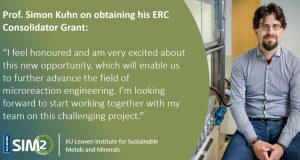— Fabio Cameli, KU Leuven
I recently read a tweet saying: “The same boiling water that softens the potato hardens the egg. It`s about what you`re made of not the circumstances”. Actually, microwave technology is essentially based on the same concept: different materials will behave differently under a microwave field resulting in what is called “selective heating”. In fact, it seems like microwaves prefer to heat up a certain substance rather than another one even though the irradiating electromagnetic field is the same for both of them.
In reality, it is because of the material properties that two objects get a different heating profile: the interaction between matter and microwave field is quantified by the complex dielectric permittivity:
![]()
where ε0 is the vacuum dielectric permittivity, ε’and ε” are the real and imaginary part, ε’r and ε”r are the real and imaginary parts of the relative dielectric permittivity.
An alternating electric field can induce the vibrational and rotational movement of dipoles or translation of ions promoting friction among molecules hence causing dissipation of kinetic energy into thermal energy.
The loss tangent (tanδ) characterizes the capacity of a substance to convert electromagnetic energy into thermal energy. This is the key parameter to determine whether a material will undergo a fast increase of temperature or it will actually get poorly heated as compared to a conventional heating method. The loss tangent is defined as the ratio between ε” and ε’: the first represents the efficiency of the material in dissipating electric energy into heat and the latter shows the capacity of storing electrical energy.
Three main forms of interactions between solid materials and microwaves can be categorized as:
- reflection: microwaves are reflected from the surface of conductors (metals or graphite)
- transmission: the electromagnetic wave penetrates insulating materials
- absorbtion: “dielectric lossy materials” get heated up
Other interesting features of microwave heating compared to a conventional heating method are listed below 1.

Table 1: Differences between MW and conventional heating.
As remarked before, selectivity is the most counterintuitive characteristic but it is well justified by knowing the dielectric properties of the material. For this reason doing research with microwaves means changing completely the traditional approach towards heating processes which makes microwave technology extraordinarily intriguing and that is a “matter” of fact!
- de la Hoz, Antonio, and André Loupy, eds. Microwaves in organic synthesis, 2 volume set. John Wiley & Sons, 2013.




